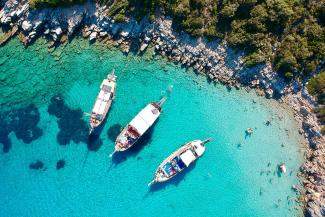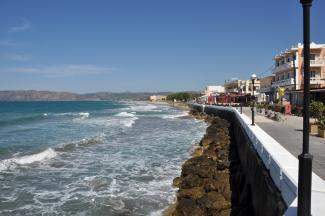
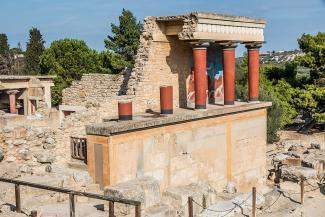
Knossos Palace, Heraklion 2024: A Gateway to Minoan Civilization
Situated at the confluence of history and mythology, the captivating island of Crete is home to the archaeological marvel known as Heraklion Knossos. Heraklion Knossos is a fascinating monument that reveals the secrets of Minoan society and is a treasure trove of history. Heraklion Knossos can transport you back in time with its extensive history and unmatched significance. We will go further into the mysterious realm of Heraklion Knossos in this piece, learning about its historical significance, architectural wonders, and the fascinating tales that lie within its old walls.

Walking Amongst the Ruins
1. A Tour of Knossos
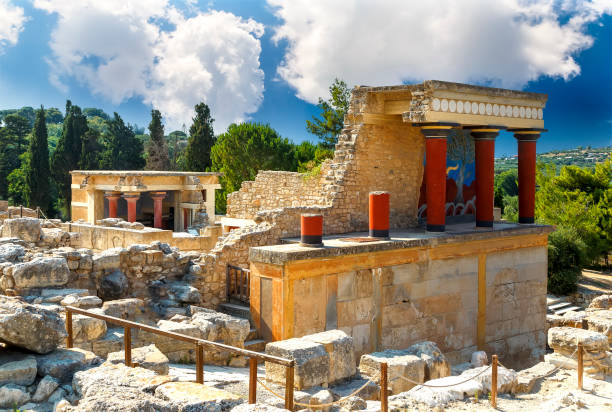
How to get to Knossos Palace from Heraklion?
On a day excursion Knossos Palace & Heraklion Tour learn about the Minoan civilization and the city of Heraklion. The palace complex at Knossos, which has a total size of around 20,000 square metres (215,000 square feet), is the site's principal draw.
Its multi-story structures, courtyards, sweeping staircases, and exquisite paintings all serve to highlight the splendour and magnificence of Minoan architecture.
Make sure to visit the Heraklion Archaeological Museum after your trip to Knossos. This journey takes you to Heraklion, where you explore the restored Archaeological Museum, which has a sizable collection of artefacts discovered at Knossos and other locations around Crete.
It is situated in Heraklion and is home to a sizable collection of Knossos and other Minoan artefacts. The museum offers more background and a greater comprehension of Minoan culture.
Unearthing History
2. A Glimpse into Minoan Civilization
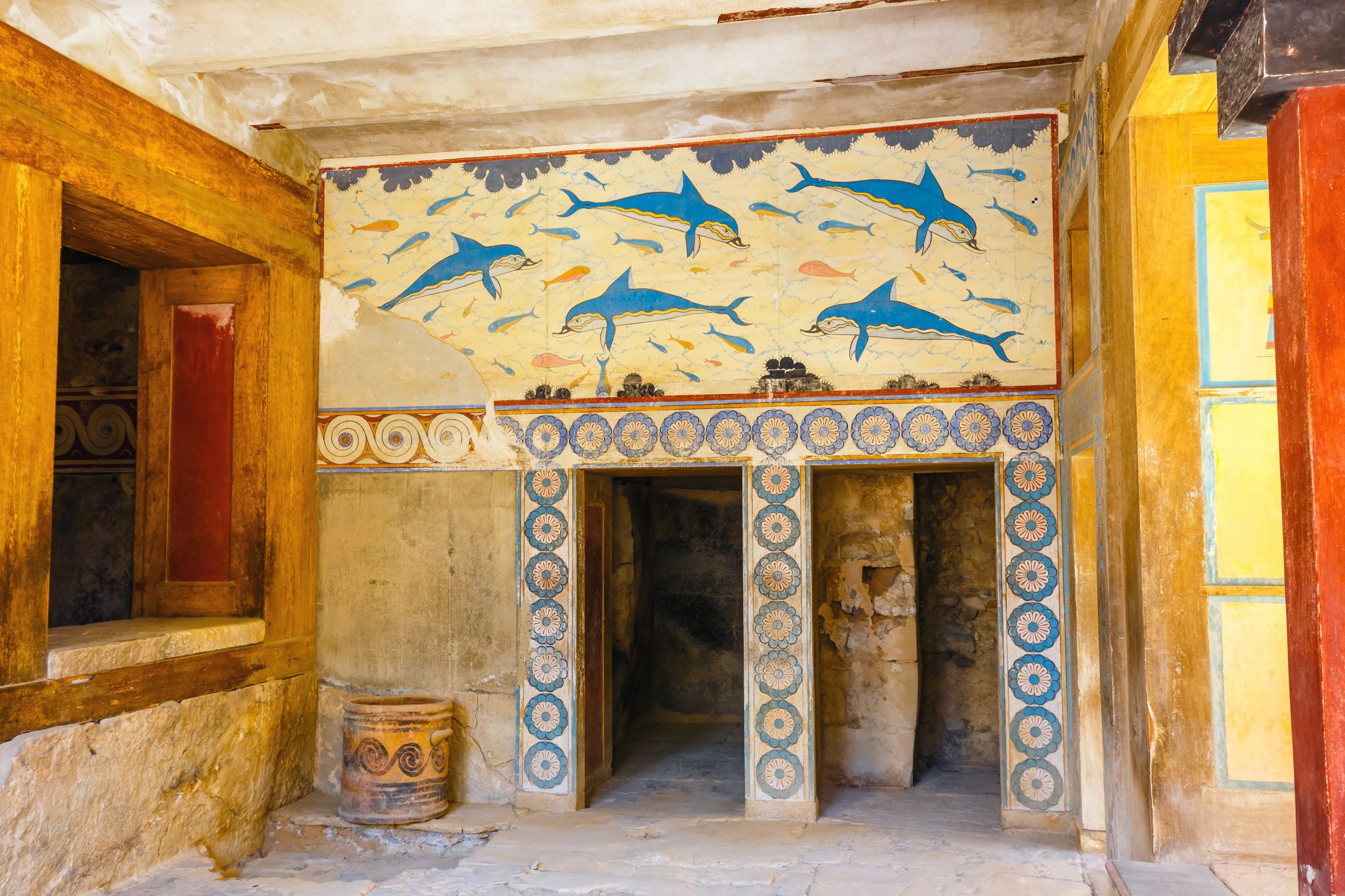
The island of Crete, which is situated in the southeast of the Mediterranean Sea, was home to the Bronze Age Minoan civilization. It is regarded as one among ancient Greece's oldest and most developed civilizations. Greek mythology mentions King Minos, a fabled monarch of Crete, as the ancestor of the Minoan civilization.
It is estimated that the Minoan culture began to flourish from 2700 BCE and continued until about 1450 BCE. The Middle Bronze Age (2000–1500 BCE) saw its zenith.
The construction of multi-story buildings, paved roads, drainage systems, and elaborate palaces are characteristics of Minoan architecture. The palace complexes, including Knossos Palace, functioned as hubs for commerce, religion, and government.
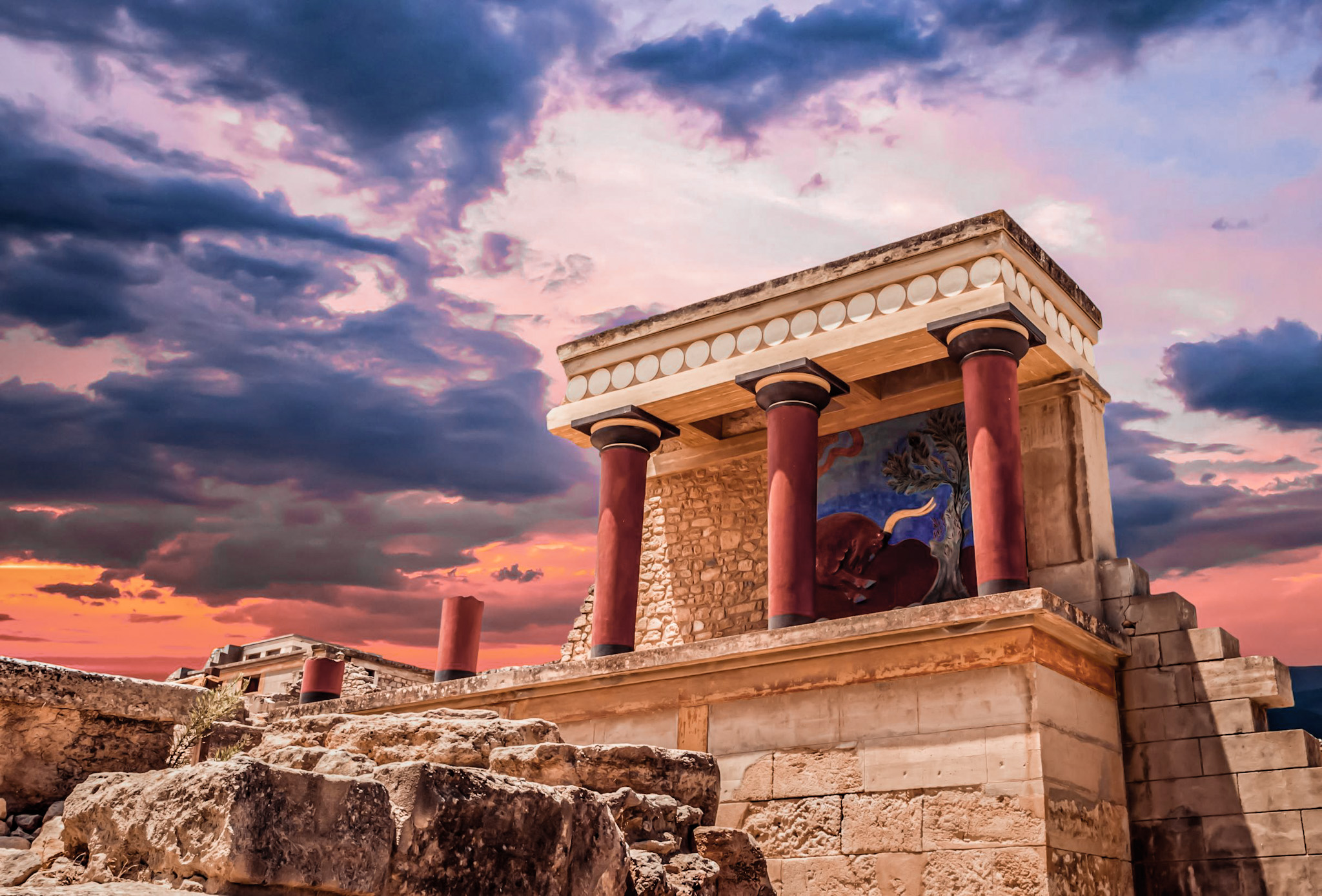
Minoan art is renowned for its realistic depictions, elaborate designs, and vivid colors. Aspects of Minoan life, like as religious rites, scenes from nature, and daily activities, were depicted in sculptures, paintings, and ceramics.
The Minoans created Linear A, a distinctive script. Unfortunately, much of the civilization's written records are still untranslated since Linear A has not been completely decoded.
Being expert navigators and traders, the Minoans founded a maritime empire that stretched well beyond Crete. They traded with several cultures in the Mediterranean, such as the Levant, Egypt, and Anatolia (present-day Turkey).

It is believed that Minoan religion was polytheistic and centered on fertility and the natural world. They used bull symbolism extensively in their religious rituals, as seen by the murals and artifacts such as the "Bull-Leaping" fresco.
Given the evidence that suggests women had significant roles in religious and social activities, some academics argue that the Minoan civilization was a rather equal society.
The precise causes of the Minoan civilization's demise are still up for question, but a number of things, such as earthquakes and other natural calamities, the eruption of the Thera volcano, and potential Greek invasions, may have had a role. Approximately 1450 BCE, the Mycenaeans eventually seized power in Crete.
3. The Palace of Knossos
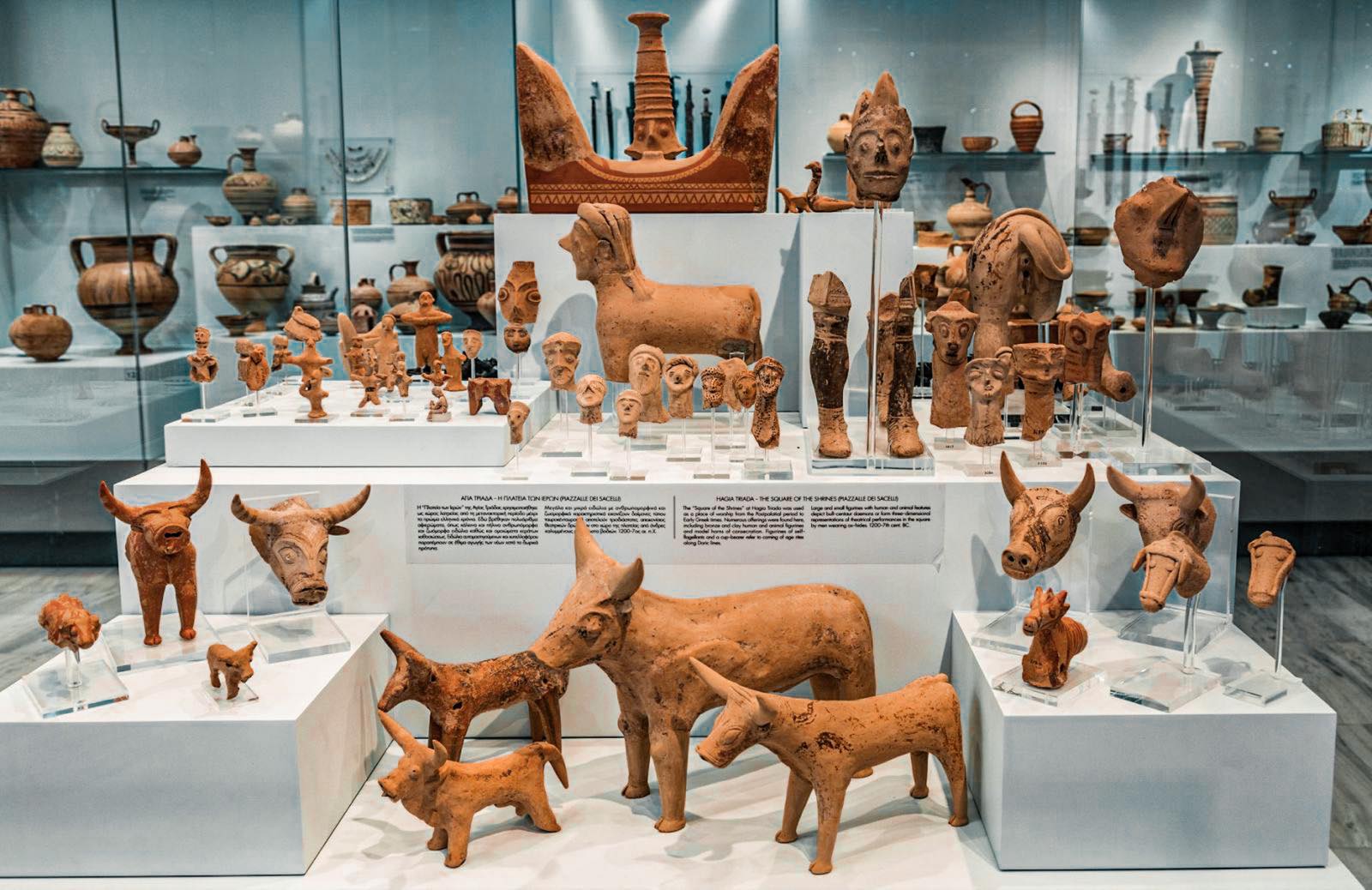
The Knossos Palace Complex is an archaeological site located near the modern city of Heraklion on the island of Crete, Greece. It is one of the most significant and well-known sites of the Minoan civilization and serves as a testament to the advanced architecture, art, and culture of ancient Crete.
The Knossos Palace Complex is a sprawling site that covers about 20,000 square meters. It consists of a labyrinthine layout with multiple levels, courtyards, rooms, corridors, and staircases. The architecture of the complex is characterized by its use of columns, frescoes, and open spaces.
The complex features a central courtyard known as the "Central Court," which is surrounded by various rooms and corridors. This courtyard likely served as a gathering place and possibly had religious or ceremonial significance.

One of the most famous rooms in the palace is the "Throne Room." This room contains a large stone bench that is often associated with the throne of King Minos, although its actual purpose remains a subject of debate among scholars.
The palace is adorned with colorful frescoes that depict scenes from daily life, religious rituals, and mythological stories. These frescoes provide valuable insights into the culture and art of the Minoan civilization.
The palace had numerous storage rooms where goods, food, and other supplies were kept. These storage areas were essential for maintaining the palace's administrative and economic functions.
The complex features several rooms and altars that suggest religious activities and rituals were important within the Minoan society. Some of the frescoes and artifacts found in these areas depict religious ceremonies and symbols.
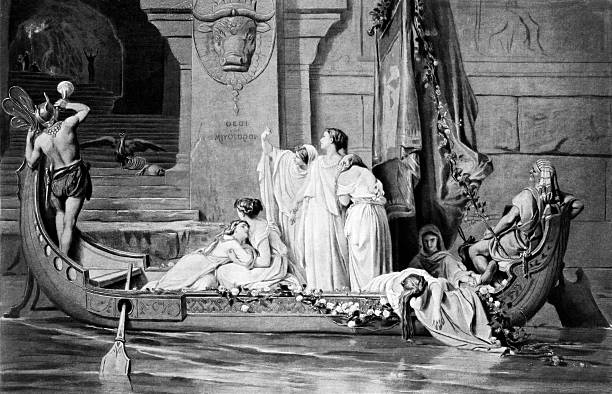
One of the most iconic frescoes from the site is the "Bull-Leaping" fresco, which portrays individuals engaging in a daring athletic feat involving bulls. This scene is believed to have cultural and religious significance.
The Knossos Palace Complex gained significant attention in the early 20th century when British archaeologist Sir Arthur Evans conducted extensive excavations at the site. Evans' interpretations and reconstructions of the palace's architecture have influenced how it is understood today.
The complex's intricate layout has led some to speculate that it inspired the myth of the Minotaur and the Labyrinth in Greek mythology, although this connection is debated.
The Legends Within
4. The Myth of the Minotaur
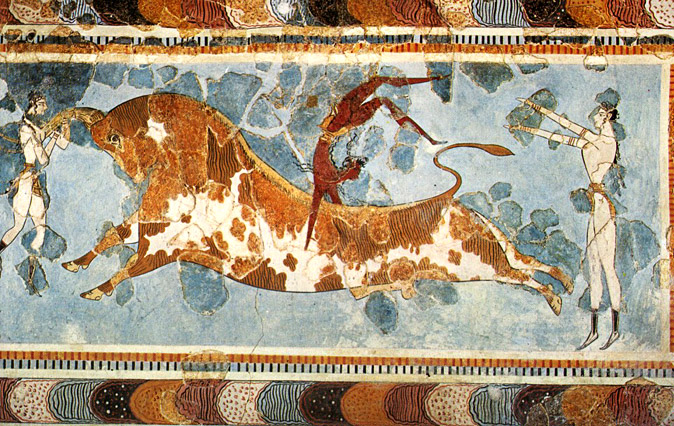
The tale of the Minotaur is among the most persistent myths connected to Knossos. Greek mythology states that King Minos of Crete ordered the construction of the labyrinth in order to house the Minotaur, a legendary beast that had a bull's head and a man's body. Explore the maze-like passageways at Knossos and picture the mystery and horror of this story.
How much are tickets for Knossos?
- Full price ticket: usually cost between €15 and €16, was the going rate for adult tourists.
- Reduced Price Ticket: Senior people, students, and residents of the European Union were eligible for reduced-price tickets. Typically, these tickets cost between €8 and €10.
- Free entrance: Students from EU nations and children under a specific age (often under 18) were frequently entitled to free entrance.
5. The Throne Room Fresco
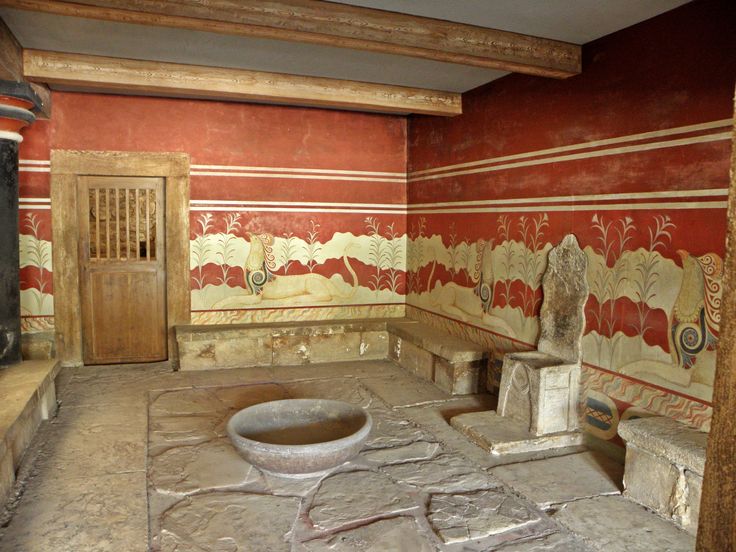
The Throne Room Fresco, a captivating work of art that has fascinated and perplexed historians for ages, is also located in Knossos. This colorful fresco depicts a person sitting on a ceremonial throne, who is frequently believed to be a priest-king. This fresco's hues and nuances offer priceless insights into the artistic ability and symbolic meaning of the Minoan culture.
Historical Significance
6. Frescoes and Artifacts

The Knossos Palace is renowned for its intricate frescoes and a wide array of artifacts that provide valuable insights into the daily life, culture, and beliefs of the Minoan civilization. These frescoes and artifacts, discovered during archaeological excavations, offer a visual and material record of the Minoans' artistic achievements and societal practices.
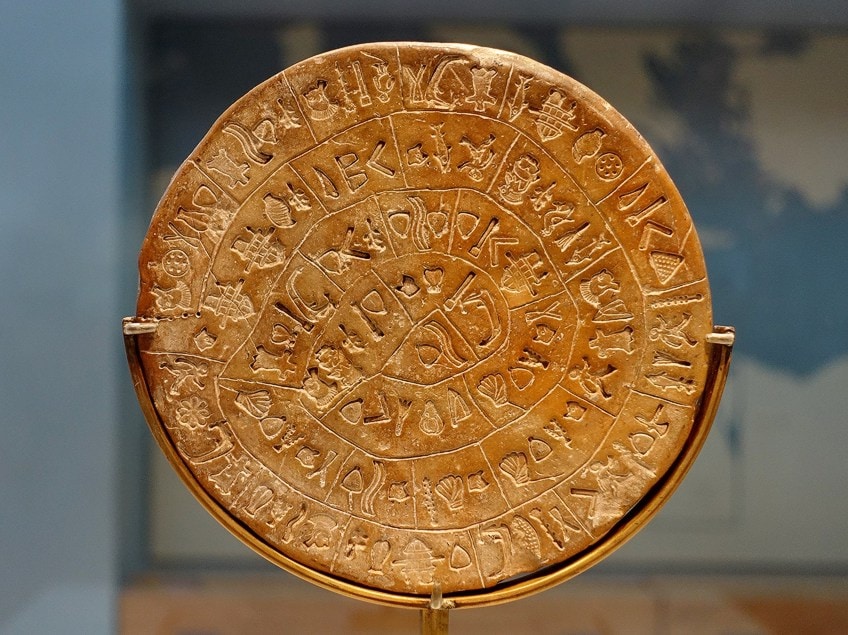
Frescoes:
Bull-Leaping Fresco: Perhaps the most iconic of all Minoan frescoes, this artwork depicts acrobats leaping over the backs of bulls in a daring athletic feat. It's believed to have cultural and religious significance, possibly representing a ritual or sport.
Dolphin Fresco: This fresco showcases dolphins swimming in a marine setting. It reflects the Minoans' connection to the sea and their maritime culture.
Prince of the Lilies Fresco: This artwork portrays a young prince or noble figure holding lilies, a symbol of purity. The fresco provides insights into Minoan fashion and clothing.
Saffron Gatherers Fresco: This fresco depicts individuals gathering saffron flowers, which were a valuable commodity. It offers insights into Minoan agricultural practices and economic activities.
Ladies in Blue Fresco: This fresco showcases women in elaborate blue clothing and jewelry. It is an example of Minoan artistic representation of the female figure.
Sacred Grove Fresco: This artwork portrays a sacred grove or garden scene, possibly associated with religious ceremonies or rituals.
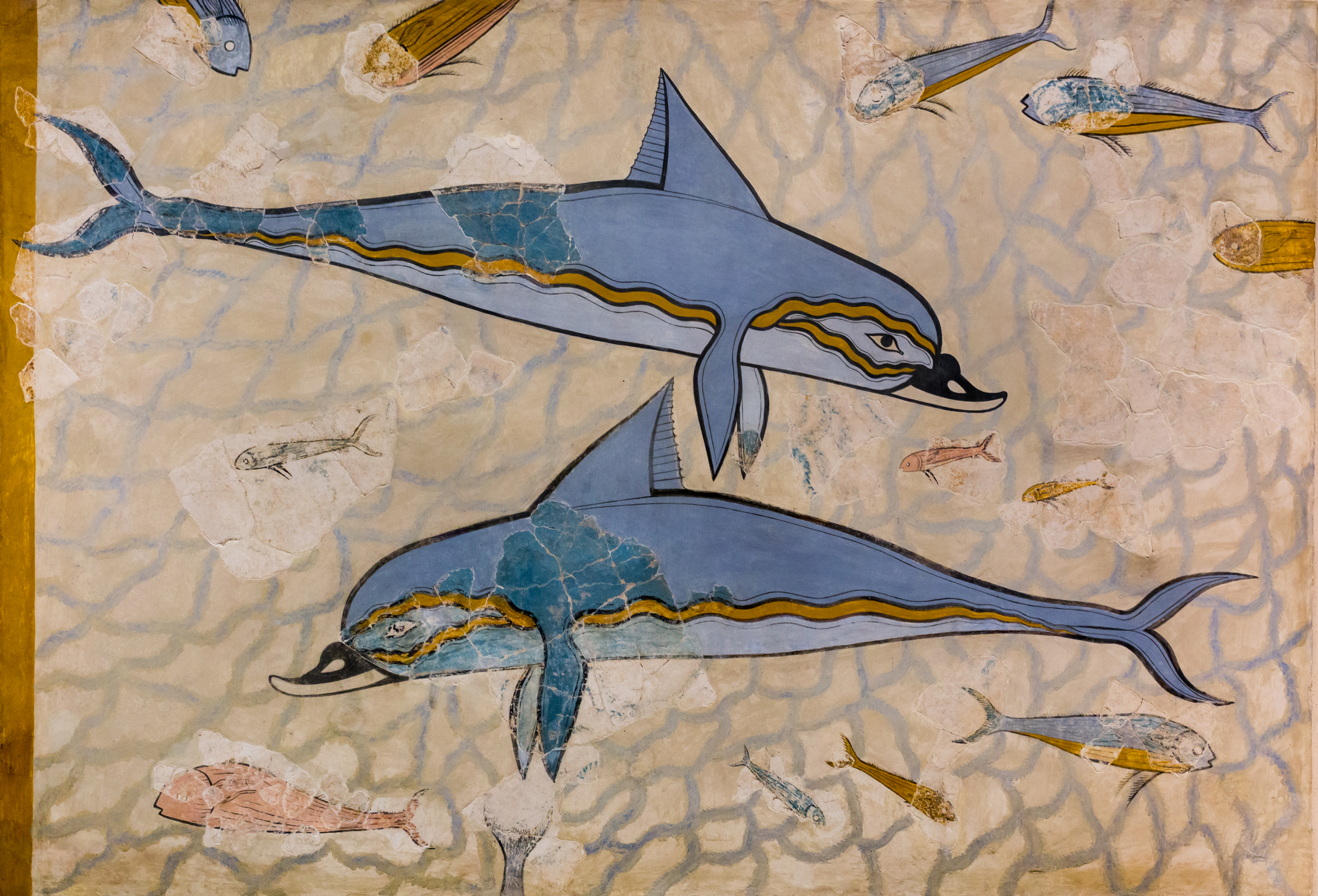
Artifacts:
Snake Goddess Figurines: These figurines depict a female figure holding snakes, which were likely symbols of power and fertility. They offer insights into Minoan religious beliefs and iconography.
Phaistos Disc: This circular clay artifact is inscribed with symbols that have yet to be fully deciphered. It is one of the most famous examples of Minoan writing.
Bee Pendant: This small gold pendant in the shape of a bee showcases the Minoans' skill in crafting intricate jewelry.
Kamares Ware Pottery: These elaborately decorated pottery pieces are known for their colorful designs and were used for various purposes, including storage and ceremonial use.
Double Axe (Labrys): The double axe was a symbol of Minoan religious and cultural significance. It appears in various forms of art and artifacts.
Seals and Sealings: Minoan seals, often made from materials like stone or faience, were used for administrative and decorative purposes. Sealings were impressions made using these seals to secure containers or documents.
Pottery and Vases: The Minoans produced a wide variety of pottery and vases with intricate designs and patterns, reflecting their artistic prowess and functional needs.
7. Exhibits and Displays
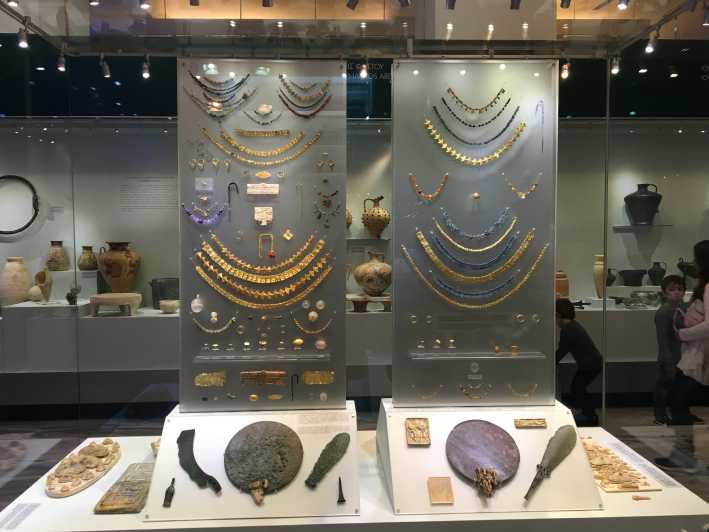
The Knossos Palace, being one of the most significant archaeological sites of the Minoan civilization, features various exhibits and displays that offer visitors a glimpse into the history, culture, and daily life of the Minoans.
The site has been organized to provide a comprehensive and educational experience for visitors who want to explore the rich heritage of ancient Crete. While I can't provide real-time information, as of my last update in September 2021.
The central courtyard area is often an open space where visitors can gather and get a sense of the palace's layout. Informational signs or panels might provide an overview of the palace's history and architecture.
Various areas of the palace site might have displays of artifacts and objects found during excavations. These exhibits can include pottery, tools, figurines, and other items that offer insights into the Minoan way of life.
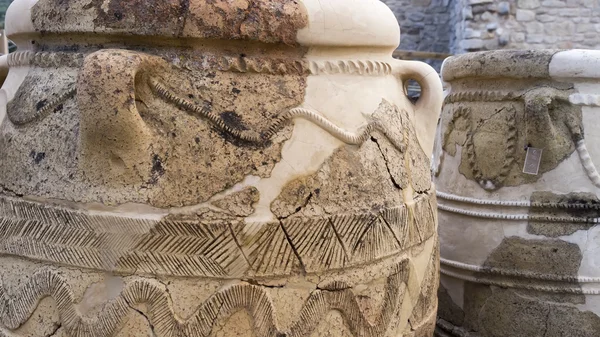
Due to the fragility of original frescoes, some displays might feature reproductions of the intricate wall paintings found in the palace. These reproductions allow visitors to appreciate the artistry and themes depicted in the frescoes.
Some modern museums associated with the site might incorporate interactive displays, touch screens, or virtual reality experiences to provide a more immersive understanding of Minoan culture and history.
Scale models or digital reconstructions might be on display to help visitors visualize what the palace and its surroundings looked like during the height of the Minoan civilization.
Informational panels, placards, or audio guides could offer detailed explanations of the palace's different areas, architectural features, and the functions they served within Minoan society.

Special exhibitions could focus on specific aspects of Minoan culture, such as religious practices, trade, or technology. These temporary displays can provide deeper insights into particular areas of interest.
Exhibits might also provide information about the broader historical context of the Minoan civilization, its interactions with other cultures, and its place in the ancient Mediterranean world.
Some sites have visitor centers where you can find more in-depth information, books, souvenirs, and possibly multimedia presentations related to the Minoan civilization and the Knossos Palace.
History and Archaeology
8. Arthur Evans

Sir Arthur Evans (1851–1941) was a British archaeologist and scholar who is best known for his extensive excavations at the Knossos Palace on the island of Crete, Greece. His work played a pivotal role in uncovering the Minoan civilization and shedding light on the ancient history of Crete.
Arthur Evans was born on July 8, 1851, in Nash Mills, England. He came from a family of academics and inherited a passion for history and archaeology.Evans conducted a series of excavations at the Knossos Palace site on Crete between 1900 and 1931. His work uncovered extensive sections of the palace complex and revealed many artifacts and frescoes that provided insights into Minoan culture.
Evans not only excavated the site but also engaged in controversial restoration and reconstruction efforts. He reconstructed parts of the palace based on his interpretation of the findings, which drew criticism from some scholars who believed he had taken creative liberties.

Evans is credited with coining the term "Minoan" to describe the civilization he uncovered on Crete. He named it after the legendary King Minos, who appears in Greek mythology.
During his excavations, Evans discovered clay tablets inscribed with a script known as Linear A. Although he made progress in identifying symbols, Linear A remains undeciphered. However, his work paved the way for the later decipherment of Linear B, another Minoan script, by Michael Ventris and others.
Evans' excavations provided a wealth of information about Minoan architecture, art, and daily life. His discoveries helped establish the significance of the Minoan civilization as one of the earliest and most advanced in the ancient world.
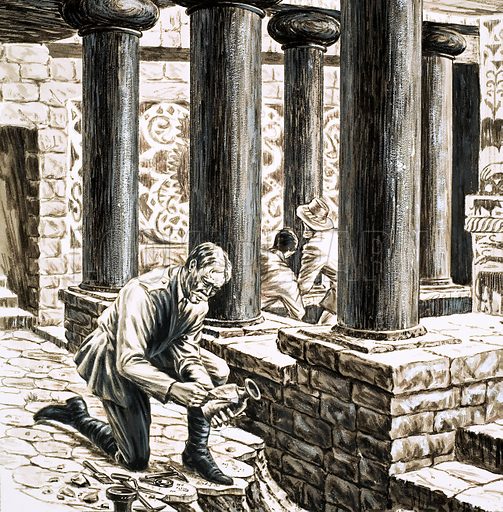
While Evans' work was groundbreaking, his reconstruction efforts have been both praised and criticized. Some believe that his interpretations influenced subsequent research and may have obscured the true historical context of the site.
Arthur Evans' contributions significantly expanded our knowledge of the Minoan civilization and its impact on ancient Mediterranean history. Despite the controversies surrounding his methods, his excavations remain pivotal in the field of archaeology.
Αrchitectural Βeauty
9. Architecture and Design

The architecture and design of the Knossos Palace are fascinating aspects that provide insights into the complexity and innovation of the Minoan civilization. The palace's layout, structures, and features showcase the Minoans' advanced understanding of architecture and their ability to create functional and aesthetically pleasing spaces.
The Knossos Palace is renowned for its labyrinthine layout, featuring a complex arrangement of interconnected rooms, corridors, staircases, and courtyards. This intricate design has led to speculation that it might have inspired the myth of the Labyrinth and the Minotaur in Greek mythology.
The palace complex consists of multi-story buildings, some of which are connected by staircases. This architectural feature allowed the Minoans to maximize the use of limited space and create multi-functional areas.

The palace includes central courtyards, such as the "Central Court," which served as open spaces for various activities, gatherings, and potentially religious ceremonies. These courtyards provided ventilation and natural light to interior spaces.
The architecture of the palace incorporates light wells, ventilation shafts, and open spaces strategically placed to enhance air circulation and natural lighting throughout the complex. This was crucial for maintaining comfortable living conditions in the Mediterranean climate.
The Minoans used columns and pillars in their architecture to support the structures and create open and airy spaces. The columns were often adorned with intricate designs and paintings.
The walls of the palace were adorned with vibrant frescoes depicting scenes from everyday life, nature, religious rituals, and mythology. These frescoes not only added to the aesthetic appeal of the palace but also conveyed cultural and symbolic meanings.
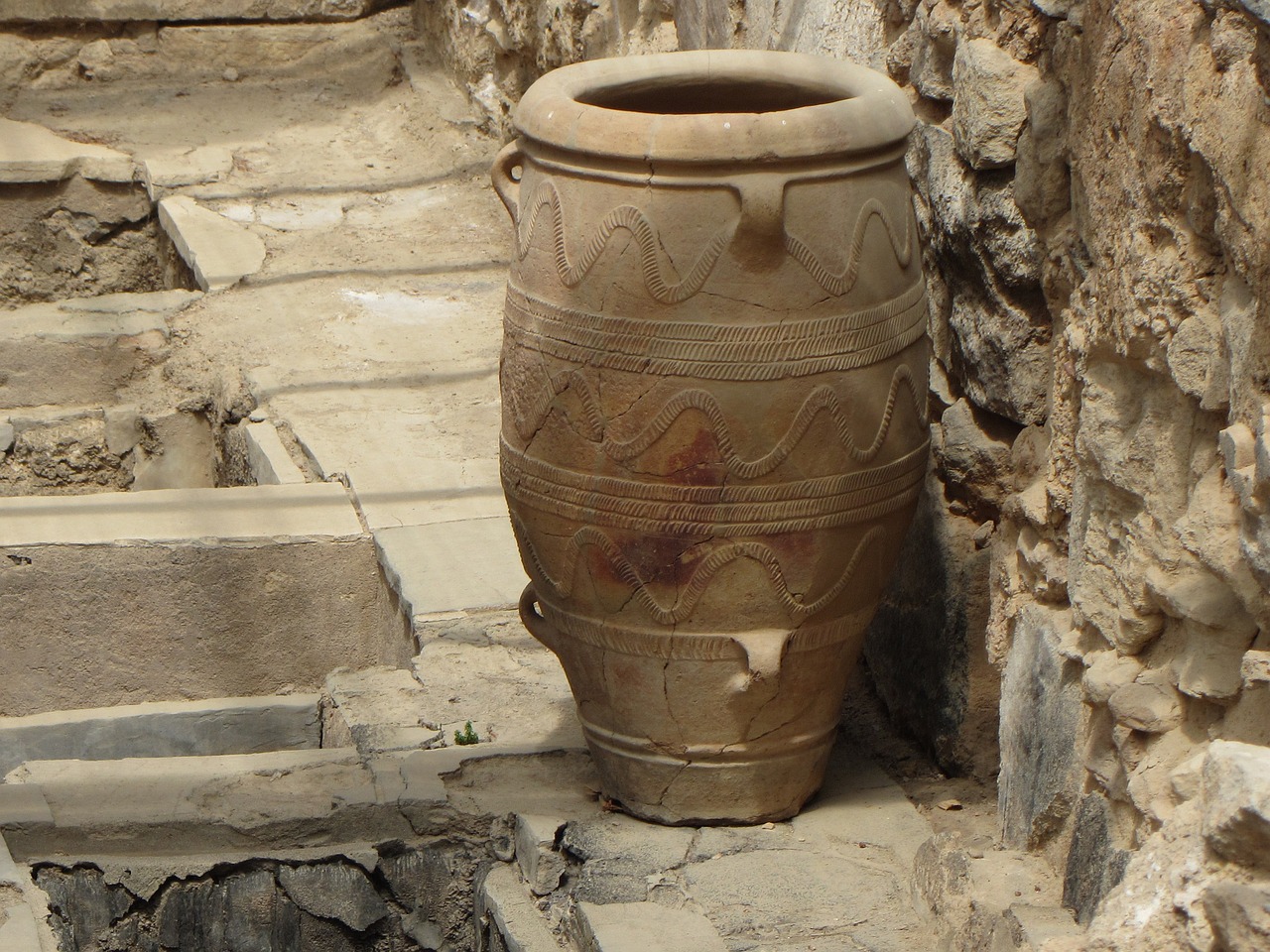
The palace complex featured numerous storage rooms for storing goods, food, and supplies. These storage areas were essential for supporting the administrative and economic functions of the palace.
The Minoans were known for their advanced plumbing and drainage systems. The palace had well-designed drainage channels and aqueducts to manage water flow and sewage.
The Minoans used a variety of materials in their architecture, including stone, wood, and clay. The use of vibrant colors in frescoes and architectural elements added to the overall visual appeal of the palace.
The architecture of the palace included specific rooms and areas likely used for religious rituals and ceremonies. These spaces might have included altars, shrines, and special chambers for important rituals.
10. Destruction and Abandonment
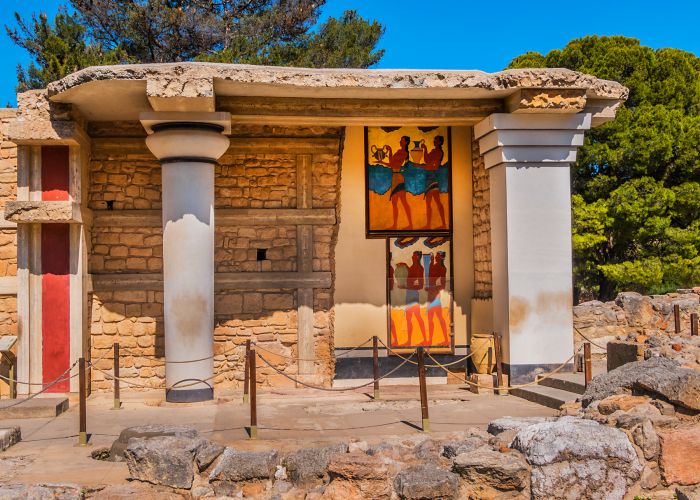
The Knossos Palace, like other ancient sites, has a complex history of destruction and abandonment. While the exact reasons for its decline are not fully understood.
The region of Crete is prone to earthquakes, and evidence suggests that the Knossos Palace experienced multiple seismic events throughout its history. These earthquakes could have caused significant damage to the structures, leading to the need for repairs and rebuilding.
One of the most significant events that may have impacted the palace and the broader Minoan civilization was the eruption of the Thera (Santorini) volcano. The eruption, which occurred around 1620 BCE, likely caused massive earthquakes, tsunamis, and volcanic ash clouds that could have affected Crete. The resulting environmental disruptions and potential damage to the palace could have played a role in its decline.
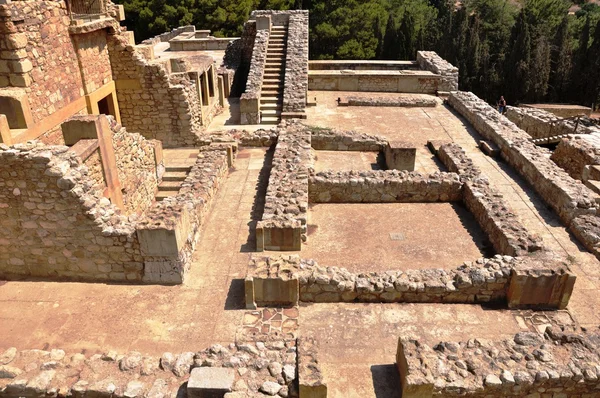
During the Late Bronze Age, the Mycenaeans, another ancient Greek civilization, gained influence and power. Some theories suggest that Mycenaean invaders played a role in the decline of Minoan civilization, including the Knossos Palace. While the extent of Mycenaean involvement is debated, there is evidence of increased Mycenaean influence on Crete during this time.
Changes in trade routes and economic structures could have affected the prosperity of the Minoan civilization, including the palace. Shifts in political and social dynamics may also have influenced the stability of the society.
It's important to note that the decline of the Knossos Palace and the Minoan civilization was likely a result of a combination of factors rather than a single catastrophic event. Economic, social, and environmental changes likely contributed to a gradual decline in the palace's significance and functionality.
Conclusion
Heraklion Knossos is a veritable gold mine of mythology, history, and prehistoric marvels. Its importance in helping to solve the puzzles surrounding the Minoan culture cannot be emphasized. The historical relics, the Palace of Knossos, and the Minotaur stories all add to the attraction of the location. A must-visit location for everyone looking to take a timeless trip through ancient history is Heraklion Knossos.


